A mouse-adapted enterovirus 71 strain causes neurological disease in mice after oral infection
- PMID: 15254164
- PMCID: PMC446098
- DOI: 10.1128/JVI.78.15.7916-7924.2004
A mouse-adapted enterovirus 71 strain causes neurological disease in mice after oral infection
Abstract
A mouse-adapted enterovirus 71 (EV71) strain with increased virulence in mice, MP4, was generated after four serial passages of the parental EV71 strain 4643 in mice. Strain MP4 exhibited a larger plaque size, grew more rapidly, and was more cytotoxic in vitro than strain 4643. Although strains 4643 and MP4 both induced apoptosis of SK-N-SH human neuroblastoma cells, MP4 was more virulent than 4643 in 1-day-old mice (50% lethal doses, 10(2) and 10(4) PFU/mouse, respectively). Strain MP4 (5 x 10(6) PFU/mouse), but not 4643, could orally infect 7-day-old mice, resulting in rear-limb paralysis followed by death 5 to 9 days after inoculation with the virus. Histopathologically, neuronal loss and apoptosis were evident in the spinal cords as well as the brain stems of the infected mice. The limb muscles displayed massive necrosis. There was early and transient virus replication in the intestines, whereas the spinal cord, brain, and muscle became the sites of viral replication during the late phase of the infection. Virus transmission occurred among infected and noninfected cagemates, as demonstrated by the occurrence of seroconversion and the presence of viable viruses in the stool samples of the latter. Protection against EV71 challenge was demonstrated following administration of hyperimmune serum 1 day after inoculation with the virus. Nucleotide sequence analysis of the genome of EV71 strain MP4 revealed four nucleotide changes on the 5' untranslated region, three on the VP2 region, and eight on the 2C region, resulting in one and four amino acid substitutions in the VP2 and 2C proteins, respectively.
Figures


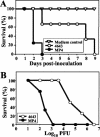
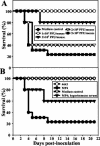
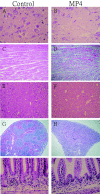
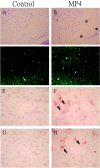
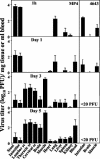
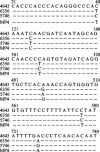
Similar articles
-
Immunity to avirulent enterovirus 71 and coxsackie A16 virus protects against enterovirus 71 infection in mice.J Virol. 2007 Oct;81(19):10310-5. doi: 10.1128/JVI.00372-07. Epub 2007 Jul 11. J Virol. 2007. PMID: 17626076 Free PMC article.
-
Pyramidal and extrapyramidal involvement in experimental infection of cynomolgus monkeys with enterovirus 71.J Med Virol. 2002 Jun;67(2):207-16. doi: 10.1002/jmv.2209. J Med Virol. 2002. PMID: 11992581
-
Mutations in VP2 and VP1 capsid proteins increase infectivity and mouse lethality of enterovirus 71 by virus binding and RNA accumulation enhancement.Virology. 2012 Jan 5;422(1):132-43. doi: 10.1016/j.virol.2011.10.015. Epub 2011 Nov 9. Virology. 2012. PMID: 22078110
-
Retrograde axonal transport: a major transmission route of enterovirus 71 in mice.J Virol. 2007 Sep;81(17):8996-9003. doi: 10.1128/JVI.00236-07. Epub 2007 Jun 13. J Virol. 2007. PMID: 17567704 Free PMC article.
-
MicroRNA and Pathogenesis of Enterovirus Infection.Viruses. 2016 Jan 6;8(1):11. doi: 10.3390/v8010011. Viruses. 2016. PMID: 26751468 Free PMC article. Review.
Cited by
-
Strategies to develop antivirals against enterovirus 71.Virol J. 2013 Jan 22;10:28. doi: 10.1186/1743-422X-10-28. Virol J. 2013. PMID: 23339605 Free PMC article. Review.
-
Cell surface nucleolin facilitates enterovirus 71 binding and infection.J Virol. 2015 Apr;89(8):4527-38. doi: 10.1128/JVI.03498-14. Epub 2015 Feb 11. J Virol. 2015. PMID: 25673703 Free PMC article.
-
Toll-Like Receptor 3 Is Involved in Detection of Enterovirus A71 Infection and Targeted by Viral 2A Protease.Viruses. 2018 Dec 5;10(12):689. doi: 10.3390/v10120689. Viruses. 2018. PMID: 30563052 Free PMC article.
-
Rosmarinic acid exhibits broad anti-enterovirus A71 activity by inhibiting the interaction between the five-fold axis of capsid VP1 and cognate sulfated receptors.Emerg Microbes Infect. 2020 Dec;9(1):1194-1205. doi: 10.1080/22221751.2020.1767512. Emerg Microbes Infect. 2020. PMID: 32397909 Free PMC article.
-
A single nucleotide in stem loop II of 5'-untranslated region contributes to virulence of enterovirus 71 in mice.PLoS One. 2011;6(11):e27082. doi: 10.1371/journal.pone.0027082. Epub 2011 Nov 1. PLoS One. 2011. PMID: 22069490 Free PMC article.
References
-
- Alexander, J. P., Jr., L. Baden, M. A. Pallansch, and L. J. Anderson. 1994. Enterovirus 71 infections and neurologic disease—United States, 1977-1991. J. Infect. Dis. 169:905-908. - PubMed
-
- Chen, Y. C., C. K. Yu, Y. F. Wang, C. C. Liu, I. J. Su, and H. Y. Lei. 2004. A murine oral enterovirus 71 infection model with central nervous system involvement. J. Gen. Virol. 85:69-77. - PubMed
-
- Chumakov, M., M. Voroshilova, L. Shindarov, I. Lavrova, L. Gracheva, G. Koroleva, S. Vasilenko, I. Brodvarova, M. Nikolova, S. Gyurova, M. Gacheva, G. Mitov, N. Ninov, E. Tsylka, I. Robinson, M. Frolova, V. Bashkirtsev, L. Martiyanova, and V. Rodin. 1979. Enterovirus 71 isolated from cases of epidemic poliomyelitis-like disease in Bulgaria. Arch. Virol. 60:329-340. - PubMed
MeSH terms
Substances
LinkOut - more resources
Full Text Sources
Other Literature Sources

